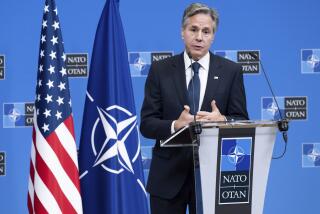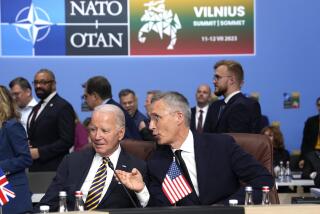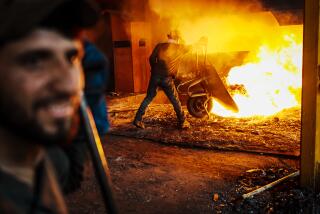Rebels could prove crucial to U.S. fight
MOSCOW — The success of American military action in Afghanistan could hinge on aid from a small, rebel Afghan army that just two weeks ago seemed on the verge of collapse.
The Northern Alliance, which includes the remnants of the forces defeated by Afghanistan’s ruling Taliban in the mid-1990s, controls less than 10 percent of the country, and its five-year war against the Taliban had ground to a halt earlier this month. Even worse, its charismatic military leader, Ahmed Shah Massood, died this month of wounds inflicted by suicide bombers.
But the alliance is showing sudden signs of life. It took the military offensive Monday by seizing a town from the Taliban in northern Afghanistan and advancing on a city that controls strategically important roads, Maza-e Sharif.
Some of the alliance’s new strength is apparently due to renewed interest from the United States and Russia. Russian President Vladimir Putin said Monday that he would supply the Afghan rebels with more arms and military equipment. And a rebel spokesman said that some of the estimated 700,000 refugees who have fled to rebel-held areas are volunteering to join the rebel ranks.
“Before the terrorism in New York and Washington, I thought the alliance would have a very bad time,” said Rashid Karimov, a scholar with the state-run Russian Institute for Strategic Studies. “But their morale is very high now, because now they and the NATO countries and the United States have a common enemy.”
Rebels date to 1980s
The alliance is undergoing an image change in almost record time -- from armed bandits who pillaged and shelled their own cities to allies in the United States’ new war against terrorism. The rebel army came into being in the 1980s when, with American financing and arms, it help defeat an occupying Soviet army. But internal rivalries led to fierce fighting in Kabul, the capital, so that Afghans welcomed the arrival of the Taliban as a force of peace.
Rebel leaders are eager to join the battle against Osama bin Laden, an ally of the Taliban’s leader, Mullah Mohammed Omar. The Northern Alliance has accused bin Laden of plotting the murder of Massood.
Northern Alliance officials say they are the natural allies of the United States: “The Afghan people are Muslim, but they are moderate,” alliance spokesman Ghulam Sakhi Ghairat said here. “They want elections. They want human rights. They want democracy. They want freedom.”
American officials are considering an alliance with rebel forces, but Ghairat said Monday that there had been no formal talks about joint military action.
Analysts say that the United States, by linking with the Muslim rebels, could prove that its quarrel is with bin Laden and his supporters, not with the Islamic world. The Northern Alliance’s guerrilla fighters could also be valuable military allies in the treacherous, mountainous terrain of Afghanistan, where they have been fighting the Taliban for five years.
Alliance wants weapons
Independent experts estimate that the rebels have about 15,000 troops. Alliance leaders claim about twice that number. They say they have no trouble recruiting Afghans who want to fight the Taliban. What they lack, they say, are weapons, ammunition and other supplies.
The Northern Alliance has about 65 Soviet-era battle tanks and armored personnel carriers, 18 MiG fighter jets, 12 ground-attack aircraft and 14 helicopters, Western experts say. But most of these antiquated MiGs, ground-attack planes and helicopters are thought to be sitting on the ground for lack of parts.
With the support of American combat helicopters and jet aircraft, some experts say, the Northern Alliance could challenge the Taliban’s 50,000-strong regular army. “If you can command the air with jets and attack helicopters,” said Chris Aaron, editor of Jane’s Intelligence Review, “then the Taliban wouldn’t stand much of a chance.”
Possible 2-pronged effort
Western experts talk of the Northern Alliance attacking the Taliban army while American and British special forces pursue bin Laden and members of his network. American and British units would still likely suffer casualties, Aaron said. But an alliance with the Afghans would greatly reduce the chances that America could become mired in a long ground war.
Some experts also see the possibility of a popular uprising against the Taliban. The government has expelled foreign aid organizations that helped feed some 5.5 million Afghans, and millions more have fled their homes.
But it’s unclear whether the rebel coalition can hold together. In recent years, the unifying force was Massood, an ethnic Tajik known as the “Lion of the Panjsher” after a gorge controlled by his forces.
Massood met his assassins -- two Arab men posing as journalists -- on Sept. 9 in Khawja Bahauddin, a town near the Tajikistan border that serves as a rebel base. He died after the two triggered a bomb hidden in their video camera. Suspicion soon fell on bin Laden.
Some intelligence analysts suspect bin Laden hoped to cripple the Taliban’s domestic opposition before the Sept. 11 terrorist attacks in the United States, to make it harder for Washington to strike back. Northern Alliance leaders say Massood’s killing was a tragic but not fatal blow to the movement.
“He gave us a very solid base to continue resistance,” Ghairat said.
Slain leader was uniter
But Aaron said Massood’s death weakens the alliance “considerably.” There may be no one capable of pulling the factions back together if they start to fight among themselves, as has happened in the past.
“They are very fractious groups in the Northern Alliance,” he said. “Massood managed to overcome that and give them a sense of purpose.”
More to Read
Sign up for Essential California
The most important California stories and recommendations in your inbox every morning.
You may occasionally receive promotional content from the Los Angeles Times.










